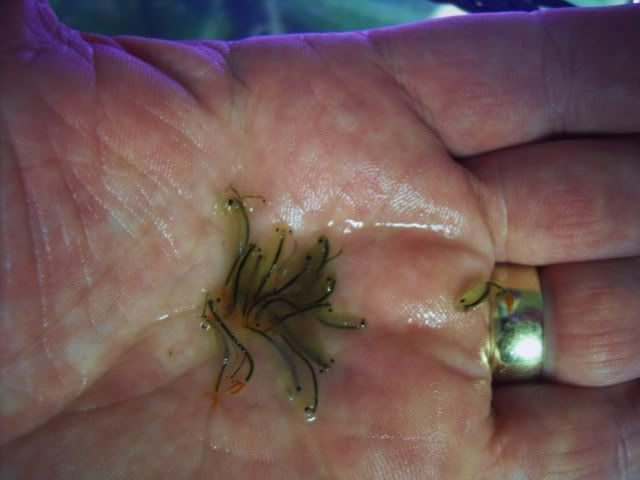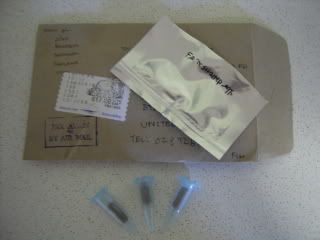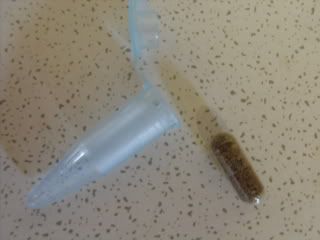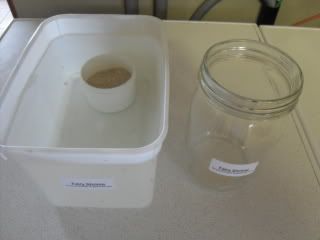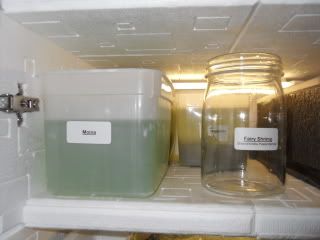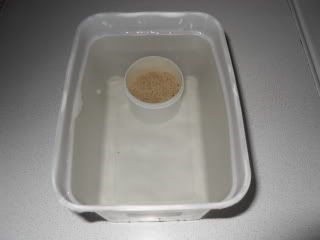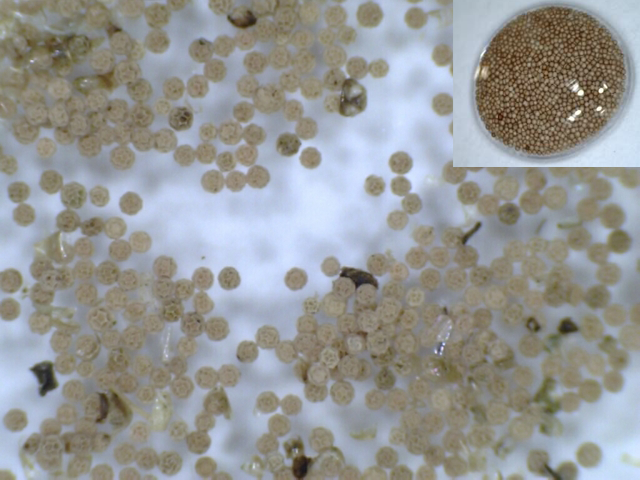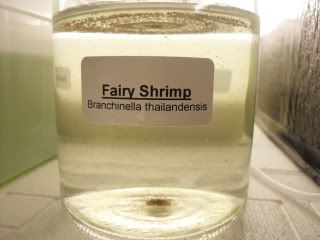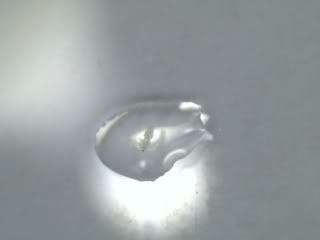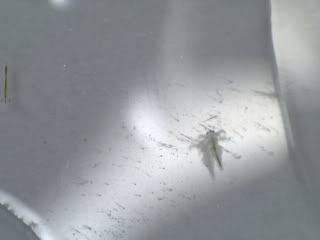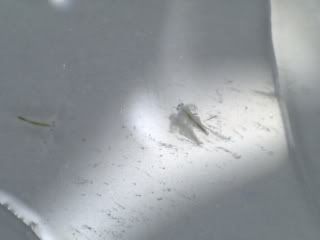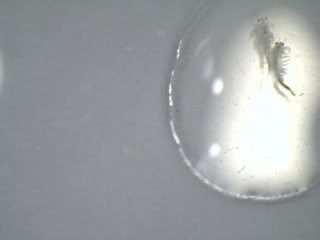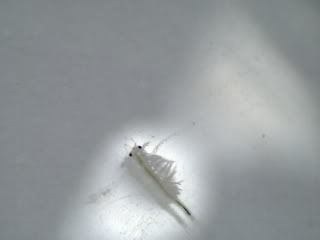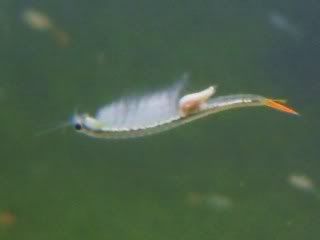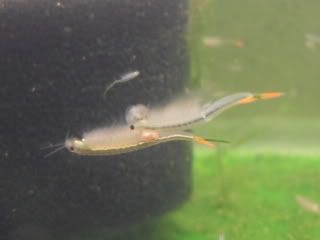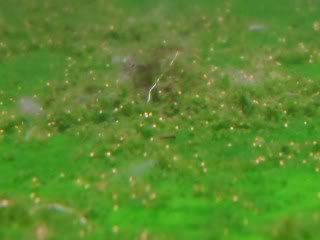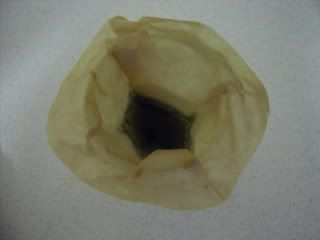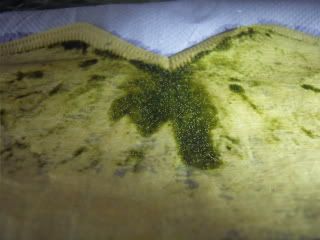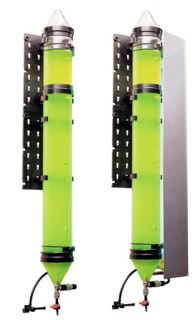Culturing Branchinella thailandensis
A Shrimp from the Orient
by
Puddlefish
This lengthy editorial was constructed by myself due to the sheer lack of non technical reference material available to the hobbyist regarding this interesting subject matter. I've scoured the internet for hours on end for relevant data that I could use and I only managed to find somewhat sketchy articles of which only just brushed on the topic. So as an endeavour to try and help other aquarists and folks interested in home aqua-culturing such creatures I have managed to put together something based solely on my personal experience. I hope you enjoy what I have managed to unearth.
This being a new venture for me and for anyone that knows me will impart that I like to culture live foods at home if possible, in an effort to give my fish a different and diverse dietary range to satisfy their everyday bodily needs. Borne out of the simplistic idea that brine shrimp need brine water, a salty mix within a specific gravity range to thrive and grow and we are predominately using freshwater as a medium for our fish which is an alien environment for Artemia to survive much longer than an hour or so. Subsequently Artemia do not live very long in freshwater tanks or fry tubs, leading to the fouling of the water which could, if left, lead to disease with resultant fish and fry losses. Thai Fairy Shrimp on the other hand would possibly fill this gap. offering me a high protein, low fat food source that would stick around longer in a freshwater environment giving fish and fry a longer time to catch and consume this fresh food source before ending up as a useless mush on the aquarium floor.
Lots of aquarists would like to give this type of food source a go, but shy away from attempts to home culture this small Crustacea species due to the fear of being duped by unscrupulous Thai vendors sending unreliable cysts through the lengthy postal delivery system. So this little article is set out with a two fold agenda, firstly to catalogue my attempts at culturing and sustaining the shrimp to subsequent populations and secondly to dispel the fear of ordering cysts from the Far East.
I'm not a fool... so realistically I would not be able to produce shrimp cysts in such numbers as to be in a position to distribute large quantities around the country. (I don't have a lake in my back yard) what I am aiming for here is to produce enough shrimp and cysts with a little effort to be able to have a self sustainable food source for both fish and fry feeding. The initial program will be primarily to grow the shrimp to adulthood and collect the cysts, this would be the number one priority. To forget about feeding anything to the fish initially until I have enough cysts to sustain future generations.
An adult of 35mm would be of no use to myself as I only keep and breed small Killifish species so for food purposes I would be only using perhaps the 1st, 2nd and 3rd instars.
What are Fairy Shrimp?
There are many species of fairy shrimp catalogued geographically around our planet, some small, some huge, but for the subject of this particular article I will be concentrating on a relatively small species from Thailand.Branchinella thailandensis.
According to published literature Branchinella thailandensis have been found in the northeastern part of Thailand since 2002. This species can potentially serve as live feed for fish and crustaceans in aquaculture because of its high nutritional value; 64.94% protein, 5.07% fat, 17.96%. carbohydrate, 8.49% ash, providing an alternative to artemia (56.4% protein, 11% fat, 12.1%. carbohydrate and 17.4% ash)
(Figures given suggest that they are of a much higher nutritional value than our other most common freshwater food resource, Daphnia).
The shrimp have adapted to living in shallow vernal pools, prone to drying out on occasion as the seasons predict. The female lays hard cased eggs (similar to Artemia cysts) that will lie dormant in the dry substrate until the pool floods once again. From cyst to adult they go through several instars. Culminating in mating and subsequent egg laying. The lifecycle of the fairy shrimp takes roughly about 6-8 weeks depending on temperature and food resources. Expect the adults reach a size of between 25 to 35mm in this short time-frame. Fairy Shrimp are filter feeders and can comsume wide range of food within the water column such as bacteria, protozoa, algae, rotifer and organic matter. As normal with this family of crustacean they are very sensitive to adverse changes in water conditions and chemicals.
Acquisition of Cysts;
Although the vendor states in his literature that he cannot be responsible for hatching rates etc, I figure I should have enough cysts and hopefully subsequent shrimp to get me to the next stage. Which ultimately would be to raise as many shrimp as possible to adulthood and collect the eggs they produce.
Aquaculturing;
As with all my articles, the findings therein this particular study is purely gathered from my own experiences on the subject matter. Many aquarists may find different methods in order to gain equal or higher success rates or yields. I call upon those people to make comments and offer positive suggestions surrounding this material so as others may share and educate themselves by reading these editorials.
The Container;
The first containers, like everything else are just standard jars and tubs rather than specialist dedicated vessels specifically designed for the job in hand. Initially I set up the cultures almost identical to my internal culturing of Daphnia pulex, in fact everything is essentially the same or similar. Later as the shrimp grow on towards adulthood I will move them into a proper all glass aquarium with a view to collecting the eggs.
When first setting up all of the vessels they have to be sterilised with a very mild bleach solution after which they were thoroughly rinsed with fresh water and meticulousness dried out. If you are attempting to culture these crustaceans sometime in the future don't be tempted to use other chemical washing-up liquids to clean your containers as the residue they leave behind will kill the shrimp.
The Water;
The water I use for the shrimp is nothing fancy, just rainwater in a clean sterile container with the pH adjusted to 7.6. by means of Bicarbonate of Soda. The temperature is kept at around 22'C. Added to the set-up is a small tub of Aragonite sand to help keep the pH up.
The Cysts;
You can differentiate Branchinella thailandensis cysts from other fairy shrimp in the region just by observing the shape of their eggs casings. Thai fairy shrimp cysts are spherical with many irregular six sided indentations or dimples around its circumference. (see pic below)
Branchinella thailandensis cysts under 200x magnification. (Artemia insert)
You can see just by looking at the egg casings that they also differ from Artemia cysts (see insert) in that the casing is rough, heavily dimpled and not as smooth and uniform as the Brineshrimp cyst.
Hatching;
Now we come to the first step on our journey, the initial hatching of the first batch of cysts. I have used a whole capsule of eggs for this initial wetting. It is known from literature that all eggs must sink to the bottom in order for them to hatch. Floating eggs wont hatch by all accounts. You can use some coffee filter papers laid on top of the floating cysts to get them to absorb more water and help them to submerge. Any cysts that still manage to float you can re-dry (see later in thread) and hatch at a later stage for more shrimp
The cysts will immediately begin to absorb water, and will eventually sink to the bottom of the jar. The baby shrimp will not hatch straight away until they are convinced that the water body is permanent. This will take about 24 to 48 hours, sometimes longer, depending on conditions. After the allotted time the nauplii will hatch and begin swimming with jerky movements as they propel themselves through the water column. The do not need to be fed until the second day. They are very small and a small (20x) lens or eye loupe will help you to see them much better. They are "photo-tropic" so if you shine a beam of light through the jar they will congregate near the light source and will be more visible. Unlike brineshrimp vigorous agitation of the water is not required to trigger fairy shrimp to hatch.
21/06/2010 The first batch of eggs are prepared and readied for hatch as per above images. 24 hours later, as expected, the first shrimp have hatched, lots of them, they resemble artemia nauplii with almost identical swimming patterns. My little 200x microscope just isn't quite up to the task in these early stages of life but should come into it's own in the days ahead.
One observation....by comparison, the nauplii of Branchinella thailandensis are almost transparent, opaque white in colour unlike brineshrimp which are orange. I have administered a small feed (20ml) of live algae to the culture jar, just enough to tinge the water green.
Feeding;
Fairy shrimp are filter feeders, They strain tiny particles out of the water for food, in the wild this would mean mostly bacteria, algae, and fungal spores. In captivity I feed them "Green Water" live algae which I culture myself. (details of how to culture this green soup can be found within my Daphnia pulex thread)
You can determine how much food is enough by using this rule of thumb: The water should be slightly hazy, but not cloudy. You should be able to see through it. If it becomes cloudy, stop feeding for a day or two until it clears up. If it becomes extremely clear, feed a little bit more. Increase their food as they grow. At about 2 weeks, the shrimp will need approximately 1 ml per day. When they are fully grown, they will need up to 3 mls daily.
Growth;
Growth of fairy shrimp is pretty rapid, it has to be with such a short lifespan. They will reach adulthood when they are about 12mm long. By four weeks old, they should be close to 25mm long. On conferring with shrimp farms in the far east, they seem to recommend a density of around 15 shrimp per litre of water once they reach adulthood. Here follows a series of images cataloguing the growth of Branchinella thailandensis.
After the third week, (21 days) I again, transfer all the shrimp and contents of their original container (3lb Ice Cream carton) into larger quarters (an all glass tank 10x10x18). This allows them a much more commodious space in which to grow out. Much more live algae is being consumed than before. 200mls of the elixir is now being added which gradually is being taken up by the shrimp, this murky soup clears after 48 hours to which another dose of food is administered. Large males are starting to spar at this stage. Females are maturing and are carrying white eggs awaiting fertilisation which will darken and form a hardshell cyst after 24 hours, these cysts will subsequently be released to lay dormant on the aquarium floor ready to be harvested in another month or so.
Reproduction;
Once the shrimp reach maturity they will concentrate exclusively on breeding . The male's objective now is to fertilise a female to make new viable cysts. The females will begin to produce eggs as soon as they mature. The bright white eggs are stored in a transparent cigar shaped pouch that is attached to their abdomen. This brood pouch makes the female easy to identify. The male shrimp constantly swims around looking for a suitable female. When he finds one, he will grab her with his large antennae. The antennae look like walrus tusks attached to his face. He will quickly fertilize her eggs and swim off to find another suitable mate. You can tell when the eggs have been fertilized because they will grow larger and turn a pale tan colour as they begin to develop a cyst coating. Once the cysts are fully coated, the female will push them out of her pouch, where they will sink to the bottom of the container.
(ii) B. thailandensis cysts litter the substrate of the container
The little embryos inside will grow and develop for about a day or two. When they reach the point of about 4,000 cells they will shut down and become dormant. They will not hatch until they are completely dried out, chilled and re-wetted. One point to note here is, that from published literature, which recommends that it is better to leave the cysts in the parent aquarium for around two to four weeks after all shrimp have expired which allows the resting shrimp embryo to fully develop before entering its diapause (resting) stage.
The Next Generation;
Afer 6-8 weeks the shrimp will start to die off due to their life cycle having run its course, we should, by this time have many cysts strewn all around the floor of their container. You cannot hatch these eggs straight away. They have to be harvested, dried and refrigerated for a week or so before starting the cycle all over again.
To harvest the cysts I use a clean meat/turkey baster and suck all the gunk from the floor of the container, I then squirt this through coffee filters. One full baster full of gunk laden water to each coffee filter is ample.
(ii) Freshly collected substrate from the base of the Shrimp's aquarium
I open out the coffee filter fully by carefully tearing down the seam. The filter is then outspread on layers of paper hand towel to soak up the excess water. This can now be left to dry out fully on top of the aquarium cover glass.
(ii) Newly collected Shrimp eggs under 200x magnification
Don't worry about harming the shrimp as they are safely encapsulated inside their hard cased shell. Once fully dried you can place the collected gunk into a small plastic bag and place in the fridge for around a week (this seems to yield better results for subsequent hatches). After this allotted time I can then start the process over again only this time around as with subsequent hatches I can sacrifice some of the shrimp as fish food. After a period of time the fish will reap the rewards more and more as your stock of shrimp cysts increases.
Observations;
21/06/2010 - Initial setting up and egg immersion
30/06/2010 - Not all the shrimp seem to be developing at the same rate and are maturing at different times - due to the probability that not all eggs might have been laid/hatched at the same time.
10/07/2010 - White eggs become apparent in brood pouches of 10mm females - Maturing males sparring.
11/07/2010 - Eggs within above females darken in colour (hardshell cyst formation)
13/07/2010 - It is noticeable that a great many eggs are strew amongst the debris on the base of the container
21/07/2010 - I sacrificed a medium sized shrimp today and placed it into a breeding tank containing adult Rivulus punctatus. The shrimp was taken with relish by a lucky female. I now know that the fish will eat the shrimp.
Future Developments;
This project was a scratch at the surface, a tentative approach to shrimp culturing. For the future I will be using adapted upturned 15 litre water vessels, the type used on drinks dispensers within foyers of office blocks. I'm also looking into the prospect of upping my algae production by purchasing a couple of Aqua Medic Plankton Reactors (see below) and adding CO2. This I feel is both a necessity and a natural progression if I'm to feed my cultures of Daphnia pulex and Moina as well as the shrimp.
Conclusion;
Seeing as I'm essentially only a hobbyist dabbling in culturing certain terrestrial and aquatic live-foods this operation is diminutive as shrimp aquaculture goes, it's adequate for my present needs. I do feel however that I would get better results by scaling up to larger vessels and dedicated filtration etc. something I'm in the process of accessing.
I hope you have enjoyed this lengthy insight into the way I culture Thai Fairy Shrimp. It's a fairly easy process if certain parameters are followed. Admittedly it takes a little while to amass a decent quantity of cysts to begin feeding to the fish, but whilst you wait for this to happen you can enjoy observing the life-cycle of this truly amazing little creature.
Thanks for viewing and I hope you have enjoyed reading this detailed editorial as much as I've enjoyed compiling it.
Additional Reference Material
The cyst hatching pattern of the Thai Fairy Shrimp, Branchinella thailandensis Sanoamuang, Saengphan & Murugan, 2002 (Anostraca)
All photographs by the author (except Aqua Medic Reactors) please do not use without prior permission.
Regards
C
-----------------------------------------------------------------------------------------------------------------------------------------------------------------------------------------------------------------------------------------------------------------------------------------
UPDATE
Just a little update on the harvesting of B. thailandensis. It has struck me that the coffee filter method may be a little haphazard as when the filter becomes soggy some eggs are lost through the paper.
What I would now recommend is to suck all the gunk from the base of the aquarium into a small glass jar each time waiting for everything to settle then extract as much of the water as possible (syringe and airline attached). Once you have everything collected and most of the excess water extracted, then, simply leave the jar in a warm place (top of an aquarium light canopy or fish-house shelf) and allow the rest of the moisture to evaporate naturally. Once totally dry, cap the jar and place in the fridge for around a week. After which, simply take you jar laden with shrimp eggs from the fridge and place this into a larger vessel filled with water and let the shrimp hatch naturally from there.
Regards
Colin


